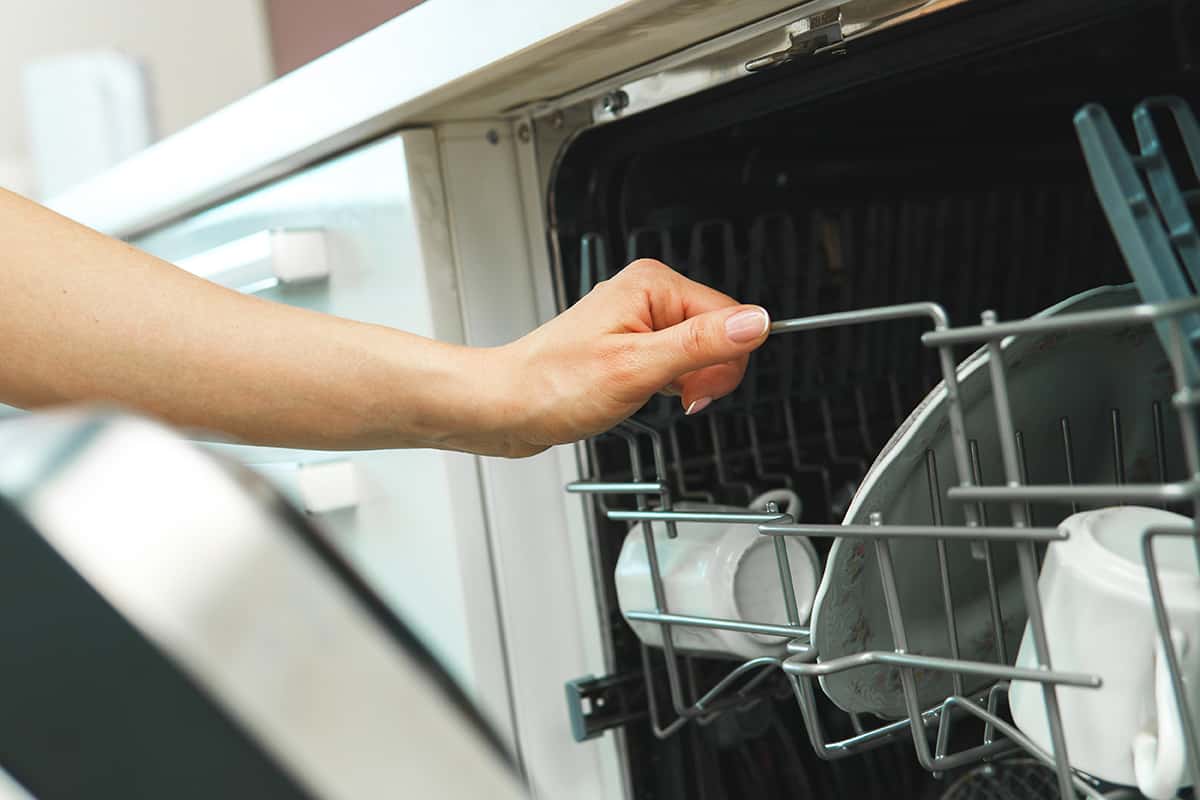A dishwasher is a vital tool in every home, handling the daunting task of scrubbing dishes clean while we relax. Its effectiveness hinges on its ability to heat water, which not only aids in sanitizing dishes but also dissolves detergent for an efficient clean. However, when your dishwasher isn’t getting hot, it compromises the cleanliness of your dishes and may even affect the longevity of your appliance.
The primary causes of a dishwasher failing to heat up could include a faulty heating element, inaccurate temperature regulation by the thermostat, a malfunctioning timer disrupting the heating cycle, issues with the high-limit thermostat, or even an inadequate hot water supply from your home’s plumbing system.
This guide will discuss how to remedy a dishwasher that’s not getting hot. We’ll discuss common symptoms, potential causes, and effective solutions.
The Basics of Dishwasher Functioning

A dishwasher operates in stages, each playing a crucial role in the cleaning process. Here’s a simplified overview of its typical cycle:
- Filling: When you start a dishwasher cycle, the appliance begins by pulling in water from your home’s supply. An inlet valve located at the bottom opens to allow this water in. The volume of water it draws depends on the specific wash cycle you’ve selected.
- Heating: After the dishwasher fills with water, it needs to heat this water to a suitable temperature for effective cleaning—typically between 110 and 160°F. This is where the heating element, located at the bottom of the dishwasher, comes into play.
- Distributing: Next, the dishwasher pumps this hot water up to the spray arms, which spin and distribute the water across your loaded dishes. Combined with the detergent you’ve added, this hot water helps break down food residues.
- Draining: After the washing phase, the dishwasher drains the dirty water. A pump directs this water out through a drain hose and into your home’s plumbing system.
- Rinsing and Drying: The dishwasher then refills with water for a rinse cycle. After rinsing, it heats the air inside to help dry the dishes. This heated drying phase again relies on the heating element.
Potential Causes for a Dishwasher Not Getting Hot
If you’ve observed that your dishwasher isn’t heating the water or drying your dishes properly, it’s likely due to specific components not functioning as they should. Let’s delve into some of these potential causes.
1. Faulty Heating Element
Heating elements can fail over time due to wear and tear or could become coated with hard water minerals, decreasing their efficiency. An electric current passing through the element heats the water, and if there’s a break in the circuit—which could be due to a faulty wire or a broken element itself—it won’t heat.
2. Thermostat Issue
The thermostat in your dishwasher regulates the water temperature by signaling the heating element to heat the water until it reaches the set temperature. It also controls the temperature during the drying cycle. If the thermostat is faulty, it may not signal the heating element correctly, leading to water that isn’t hot enough or, sometimes, too hot.
3. Broken Timer
A dishwasher’s timer controls the duration of each cycle, including the heating phase. If the timer is broken, it could cut the heating phase short, meaning your dishwasher doesn’t have adequate time to heat the water to the necessary temperature. A power surge, continued use, or a mechanical defect could cause the timer to malfunction. Sometimes the timer motor can burn out, or the gears can wear down over time.
4. Issues with the High Limit Thermostat
The high-limit thermostat is a safety device that prevents the dishwasher from getting too hot by cutting off power to the heating element when temperatures reach a potentially damaging level. If this component is faulty and prematurely triggered, it could interrupt the heating cycle, leading to your dishwasher not getting hot enough.
5. Inadequate Hot Water Supply
Finally, you should check your home’s hot water supply. If your home’s water heater is set too low or not functioning correctly, your dishwasher might not be getting the hot water it needs to function correctly. It could also be due to issues with the plumbing connections to the dishwasher, leading to an inadequate supply of hot water.
Solutions to Fix a Dishwasher Not Getting Hot

Once you have pinpointed the potential cause of your dishwasher not heating properly, you can address the problem. This section covers various solutions, starting with some you can try yourself before considering professional help.
1. Repairing or Replacing the Dishwasher’s Heating Element
If you’ve determined that the heating element is faulty, you can try cleaning it first. Sometimes, a build-up of hard water minerals can interfere with its function. A thorough cleaning with vinegar can often solve this issue.
However, if the element is broken or has a wiring issue, it will likely need to be replaced. You can order a replacement part from the dishwasher’s manufacturer or an appliance parts retailer. Once you have the part, you can replace it yourself if you feel confident, but remember to disconnect the dishwasher from the power supply before starting.
2. Fixing the Thermostat for Proper Temperature Regulation
A malfunctioning thermostat requires replacement, as it’s not a part that can be repaired. Similar to the heating element, a replacement can be ordered from the manufacturer or a parts retailer. Replacing a thermostat involves accessing the dishwasher’s underside, disconnecting the old thermostat, and installing the new one.
3. Addressing Timer and High Limit Thermostat Issues
If your dishwasher’s timer or high-limit thermostat is causing the issue, these parts will need to be replaced. You can find replacements through your dishwasher manufacturer or a third-party parts retailer.
4. Ensuring Adequate Hot Water Supply
If you suspect the problem lies with your home’s hot water supply, start by checking your water heater. It should be set to heat water to at least 120°F for the dishwasher to work efficiently. If your water heater is functioning correctly, but you’re still facing issues, it might be a problem with the plumbing connections to the dishwasher.
FAQs
1. Is it safe to run a dishwasher that’s not getting hot?
Yes, it’s generally safe to run a dishwasher that isn’t getting hot, as long as there aren’t any noticeable leaks or strange noises. However, the dishwasher might not clean your dishes effectively. The heat in a dishwasher helps to break down food particles and sanitize your dishes. Without this heat, your dishwasher might leave behind food particles, and your dishes may not be properly sanitized.
2. What are the signs of a failing dishwasher timer?
A failing dishwasher timer can exhibit a few telltale signs. You might notice that the dishwasher gets stuck on a particular part of the cycle, or it might skip stages entirely. For example, if the dishwasher moves straight from filling to draining without washing, the timer could be the issue. In other instances, the dishwasher may not start at all, or it might run for far longer than it should.
3. How can I maintain my dishwasher for long-term efficiency?
Proper maintenance can extend the life of your dishwasher and ensure it runs efficiently. Here are a few tips:
- Regular Cleaning: Clean your dishwasher regularly to remove any food particles or mineral build-up. This includes the filter, spray arms, and interior walls. You can use a dishwasher-safe cleaning solution or run a cycle with a cup of white vinegar placed upright in the top rack for a thorough clean.
- Load Correctly: Ensure you’re loading your dishwasher properly so that water can reach all the dishes. Overloading or improper loading can result in dishes not being cleaned adequately and can even strain the dishwasher’s motor.
- Use the Correct Detergent: Always use a dishwasher-safe detergent. Other types of soap can produce too many suds and potentially damage your dishwasher.






